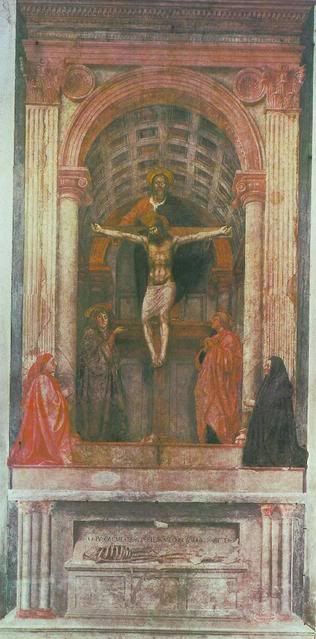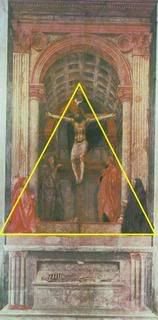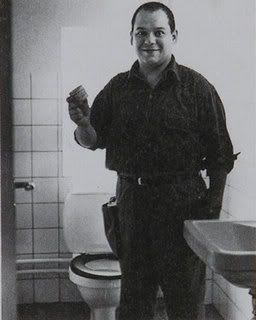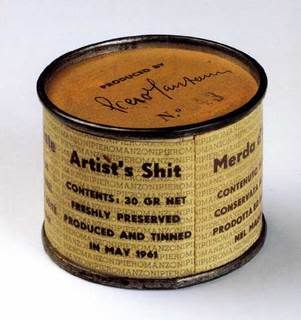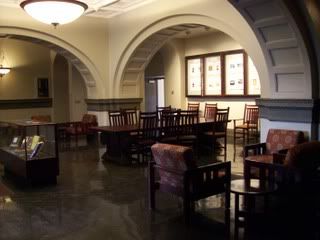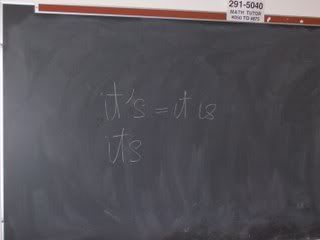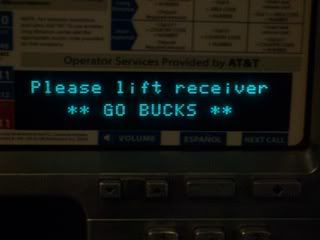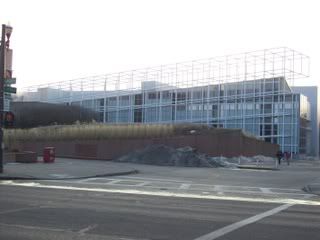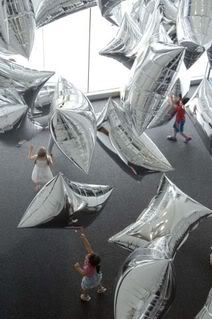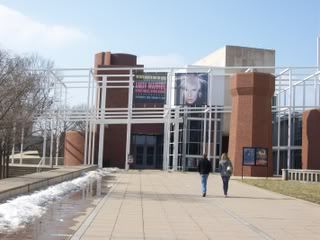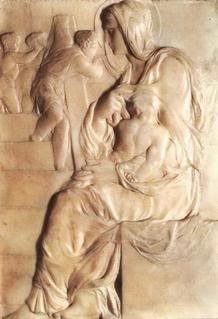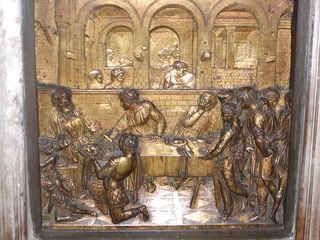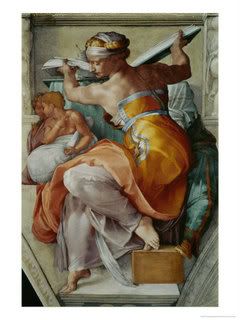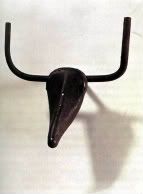I fully intended to post yesterday, in honor of Ash Wednesday, but when I got to work (where I write most entries) my boss gave me something stupid to do, so alas, it was pushed off a day. Since it's the beginning of Lent, I wanted to do something of a religious nature. Flipping through an old Art History notebook, nothing struck me as overly Lent-y, so I chose a really cool fresco to talk about.
Trinity Fresco, Masaccio, sometime between 1425 and 1428
Fun Fact- Many artists during the Renaissance only went by one name (Giotto, Donatello, Raphael, etc.). Sometimes the name they commonly went by was a nickname, or a diminutive form of their real name. Masaccio's real name was Tommaso Cassai, but the name "masaccio" basically means "big, ugly, clumsy Tom." This was to distinguish him from one of his peers, who was also named Tommaso, and whom we know as Masolino (little delicate Tom). It's kind of like on one of my soccer teams growing up, we had a "Big Megan" and a "Little Megan" because two Megans on one field is too many.
This fresco is in Santa Maria Novella, in Florence (and if I was studying abroad in Florence right now, I would certainly make a point of visiting Sta. Maria Novella because there's lots of cool stuff in there *ahem*Allie*ahem*). It is on the wall, and meant to look like another chapel because it has the illusion of receding into space. Masaccio was one of the first artists to use linear perspective, which is responsible for this illusion, and we can see evidence of it if you look at the vaulting on the pretend ceiling. If you were to extend those lines, they would all converge at a "vanishing point." In this case, our vanishing point would be somewhere right around Christ's knees.
Another big thing during the Italian Renaissance was the pyramidal structure. Artists tended to structure their paintings in a triangular shape for two reasons (that I can think of off the top of my head): a triangular structure would make for a balanced composition, and balance is aesthetically pleasing, and the triangle is related to the trinity, so it would elevate the "holiness" of the work, or at least reflect the subject matter in its form. The pyramidal structure is definitely at work here. If you connect all the people you have a nice, almost equilateral, triangle.
Let's talk about imagery. Obviously, the guy on the cross would be Jesus Christ. The old guy behind him is God the Father. Artists back then were a lot less hinky about painting images of God, and the old bearded guy with a halo is usually what they went with to depict him. The white thing on God's robe isn't a collar, but a dove, which symbolizes the Holy Spirit. So we have the Father, Son, and the Holy Spirit- the whole Trinity, hence the name of the fresco. Underneath Christ is the Virgin Mary on our left, and St. John the Baptist, on our right. The remaining two figures, outside of the fake chapel, or you could say in the viewer's space ("the real world" and out of the holy area) are two members of the Lenzi family. They commissioned Masaccio to paint this fresco, and back then it was not at all uncommon for the patrons of a piece of work to be included in it. Having your portrait associated with an image like this would 1) show how devout you are, and 2) show how wealthy you are; both of which were good things to be in 15th century Florence.
I could talk about how the architecture is classical, but I think that's probably the least interesting part of this fresco.
Here's the most interesting part: Up until 1861, the whole bottom part, underneath the step which the images of the patrons are kneeling on, was behind a stone altar and altarpiece made by Vasari. Then one day someone decided to move it (well, probably a bunch of someones, as I would imagine a stone altar would be pretty heavy), and they found this awesome, creepy part of the work that no one even knew was there! It's a sarcophagus with a skeleton inside it and an inscription that (according to Wikipedia) reads "I Was What You Are And What I Am You Shall Be." Awesome and creepy, right? Apparently it's some kind of ancient warning, but I'm not really sure what that means. The sentiment is familiar, but I've never heard that phrase before; then again, I'm not really up on my ancient warnings. One interpretation is that the skeleton is Adam's skeleton. Another take is that it's a journey to salvation. You start and end as corporeal matter, but with prayer (demonstrated by the patron portraits), and intercession (of the Virgin and Saints), you can make your way up to the Trinity and join the Kingdom of Heaven.
Another way to think of the Stairway to Heaven- baby steps toward eternal salvation.
Thursday, February 26, 2009
Wednesday, February 18, 2009
Well, Shit.
This is Piero Manzoni. I'm not going to pretend to know a lot about him, his ideas, or his work. I just want to share one thing that this crazy Italian accomplished during his short career (unfortunately he died at age 29). He pretty much took Marcel Duchamp's idea of the readymade and ran with it. My personal favorite is this little gem:
Artist's Shit, 1961
Yes, this is exactly what the name implies. Manzoni put 30 grams of his own poop into tins- 90 in all- signed them and numbered them, then sold them off for their current weight in gold. How freaking funny is that? I can't find a source for it, but I remember hearing that in recent years these cans in museums all over the world were succumbing to expanding gasses from the feces inside and exploding. Piero Manzoni may have died over 40 years ago, but he's still giggling from his grave.
Saturday, February 14, 2009
Bored tonight?
If you happen to be in the Cincinnati area this evening and are looking for something to do, you should come down to the opening reception at my gallery!!
Here's the press release (which I wrote):

Also, shout out to the cincinnati imports blog and the huge success of of the first ever Cincinnati Imports happy hour. It was a really great turnout and a lot of fun- there were tons of really cool people there. I even made the CiN Weekly photo gallery!
Here's the press release (which I wrote):
The Art on the Levee Gallery is proud to announce our Black History Month show! Featuring works by Jariel Galloway, Eugenie Goggin, Joanne Honschopp, Judi Parks, Wolfgang Ritschel, Robert Scholl, Paul Vollman, and Zeta Wolf, we have collected over 90 pieces of painting, photography, and other mediums celebrating Africa and the African American Culture.
Join us on February 14th from 4:00 pm-8:00 pm for the opening reception! We will have refreshments, jazz music by local band Ain't From Around Here, two special performances by storyteller and musician Omope Daboiku, and a performance at 5:00 by Step-n-Unity, a step team from Roger Bacon High School.
Join us on February 14th from 4:00 pm-8:00 pm for the opening reception! We will have refreshments, jazz music by local band Ain't From Around Here, two special performances by storyteller and musician Omope Daboiku, and a performance at 5:00 by Step-n-Unity, a step team from Roger Bacon High School.
Come and discover the "Lure of Africa," explore the influence of African American musicians, and consider the African American contribution to American society with these diverse and fascinating works of art! Bring your Valentine to Art on the Levee to see the show, congratulate the artists, and check out what else is new in the gallery!
The show will run from February 2nd through March 15th with the opening reception on February 14th. Please check the website and/or call us for more upcoming events during this exhibit.
Art on the Levee, a unique Art Gallery showing artwork from more than 100 local artists, is located on the Valet Circle at Newport on the Levee between to The Reserve Restaurant & Piano Lounge and Cafe Istanbul. For more information about Art on the Levee Gallery, please visit www.artonthelevee.com and for information on Newport on the Levee, please visit www.newportonthelevee.com.
The show will run from February 2nd through March 15th with the opening reception on February 14th. Please check the website and/or call us for more upcoming events during this exhibit.
Art on the Levee, a unique Art Gallery showing artwork from more than 100 local artists, is located on the Valet Circle at Newport on the Levee between to The Reserve Restaurant & Piano Lounge and Cafe Istanbul. For more information about Art on the Levee Gallery, please visit www.artonthelevee.com and for information on Newport on the Levee, please visit www.newportonthelevee.com.
Gallery Hours January and February:
Monday - Saturday: 11am -8pm
Sun. 12pm-6pm

Also, shout out to the cincinnati imports blog and the huge success of of the first ever Cincinnati Imports happy hour. It was a really great turnout and a lot of fun- there were tons of really cool people there. I even made the CiN Weekly photo gallery!
My Date With Andy Warhol, part 3
The last part of the exhibit were the two staggered rooms. These rooms held more of his art, plus a good number of the films that he made over the years. The films were projected simultaneously on different hanging screens. One room probably had 5 different movies showing, and the other probably had 12. The movies and their set-up was my biggest complaint about the whole exhibit. While some of his films were silent, many of them had sound, so the way the Wexner people set it up (or this could be the way the exhibition travels, I'm not really sure) was that in front of each screen there was an odd-shaped bench/cushion thing that you could sit on and above it was another odd shaped thing (I have no idea what to call it) in which a speaker was put, so that you could hear the movie you were sitting in front of. But, much like the speakers in the first room, the volume on most was much to low to actually make out anything that anybody was saying, and for some of them you could overhear the speakers for the film next to you. On top of that, it was unclear for some which bench matched up with which screen. So, though some of the films were kind of interesting to watch, I found the whole set up too confusing to really enjoy. Maybe this was the point, and if it was, then I'm going to go from confused to annoyed.
A few of my favorite films to watch: Outer and Inner Space, with Edie Sedgewick. This one is meant for a double screen. All it is is Edie Sedgewick sitting there, talking, next to a TV where a pre-recorded profile of Edie Sedgewick was talking. On one screen there was a zoomed in image of this, and the other screen was zoomed out. So there were four Edies and they all looked like they were talking to each other. Even if the volume wasn't so low, you still wouldn't really be able to hear what she was saying because they were all talking at the same time. That was probably my favorite. I also really enjoyed the one where Warhol filmed the Velvet Underground rehearsing, and then being busted in on by the police. Even after the police came in and they stopped playing, the camera kept rolling and you could see people just milling around and Andy talking to the police.
I mentioned that a lot of his other work was in these two rooms. There were tons of silk-screens (probably 20 different soup cans, a few Elvises, a gun), a few drawings, and a few sculptures (the Brillo Pad boxes). But this led to another problem, and what was essentially the main problem with this part of the exhibit. These two rooms were really tall, but thin. Some of his work was hung up so high that you couldn't see it, or you couldn't see it without getting dizzy. It was impossible to go to the far side of the room and look up, because there were screens everywhere. The main problem with the exhibit was that they had too much stuff and not enough space. I understand wanting to get as much as possible in your exhibit, but I think that the overall experience would have improved with maybe 4 or 5 less movies, and either less silkscreens, or putting some of them in other parts of the center (and there was plenty of room where they could have been put to be seen better).
Overall I think they did a really kick- as job, but when I'm in charge, we'll go for quality, not quantity.
On my way out, of course I stopped at the gift shop. I really wanted an exhibition catalogue, and since I got in for free, I figured I could afford it, especially considering everything was 30% off, due to it being the end of the run. But the price of the catalogue was $50! Whoa, no thank you.
Since I was already at OSU and Nick told me not to hurry home on account of his workload, I figured I'd go check out the Art History building, since I applied to grad school there. Hayes Hall. A decent looking red building (I forgot to get a picture of the outside). In the front hall there was a little lounge area with some chairs and two cases of faculty publications. It was quite something.
I walked around and looked into some of the classrooms. Decent sized rooms for small-ish classes. I found this written on the board of a seminar room, which made me smile:
I looked at the doors of the faculty offices, where they had little fliers of the classes they teach. I didn't think so, but it looks like the faculty might match my interests pretty well after all. There seemed to be good representation of the medieval/Italian Renaissance classes.
I passed a pay phone and was amused to see it flashing this:
We didn't have this kind of school spirit at Kenyon.
After my self-tour of the art history building, I walked around the Oval Mall a little bit, but there wasn't a whole lot to see on a Sunday evening. The big library is under construction, slated to be open this summer, so if I did decide on OSU they will have a newly-remodeled library which will probably be pretty sweet. I left campus and walked up and down High Street a bit and decided to grab a quick and cheap dinner at The Flying Pizza
It was a little hole-in-the-wall, pizza by the slice place. It wasn't the most fantastic pizza I've ever had but for two big slices and a pop for $6, I was happy with it.
Since I was parked next to one of the smaller libraries, I decided to check it out and see what OSU students were doing without their main library. This library wasn't exactly small, but with so many freaking students, they were all crammed in together. There's no way I could study if everybody and their brother was at the table with me, so I'm sure they will be just as happy to see the main library re-open as I would be.
Satisfied with my date with Andy Warhol and my tour of Ohio State, I headed back to my car and hit the open road back to Cincinnati.
A few of my favorite films to watch: Outer and Inner Space, with Edie Sedgewick. This one is meant for a double screen. All it is is Edie Sedgewick sitting there, talking, next to a TV where a pre-recorded profile of Edie Sedgewick was talking. On one screen there was a zoomed in image of this, and the other screen was zoomed out. So there were four Edies and they all looked like they were talking to each other. Even if the volume wasn't so low, you still wouldn't really be able to hear what she was saying because they were all talking at the same time. That was probably my favorite. I also really enjoyed the one where Warhol filmed the Velvet Underground rehearsing, and then being busted in on by the police. Even after the police came in and they stopped playing, the camera kept rolling and you could see people just milling around and Andy talking to the police.
I mentioned that a lot of his other work was in these two rooms. There were tons of silk-screens (probably 20 different soup cans, a few Elvises, a gun), a few drawings, and a few sculptures (the Brillo Pad boxes). But this led to another problem, and what was essentially the main problem with this part of the exhibit. These two rooms were really tall, but thin. Some of his work was hung up so high that you couldn't see it, or you couldn't see it without getting dizzy. It was impossible to go to the far side of the room and look up, because there were screens everywhere. The main problem with the exhibit was that they had too much stuff and not enough space. I understand wanting to get as much as possible in your exhibit, but I think that the overall experience would have improved with maybe 4 or 5 less movies, and either less silkscreens, or putting some of them in other parts of the center (and there was plenty of room where they could have been put to be seen better).
Overall I think they did a really kick- as job, but when I'm in charge, we'll go for quality, not quantity.
On my way out, of course I stopped at the gift shop. I really wanted an exhibition catalogue, and since I got in for free, I figured I could afford it, especially considering everything was 30% off, due to it being the end of the run. But the price of the catalogue was $50! Whoa, no thank you.
Since I was already at OSU and Nick told me not to hurry home on account of his workload, I figured I'd go check out the Art History building, since I applied to grad school there. Hayes Hall. A decent looking red building (I forgot to get a picture of the outside). In the front hall there was a little lounge area with some chairs and two cases of faculty publications. It was quite something.
I walked around and looked into some of the classrooms. Decent sized rooms for small-ish classes. I found this written on the board of a seminar room, which made me smile:
I looked at the doors of the faculty offices, where they had little fliers of the classes they teach. I didn't think so, but it looks like the faculty might match my interests pretty well after all. There seemed to be good representation of the medieval/Italian Renaissance classes.
I passed a pay phone and was amused to see it flashing this:
We didn't have this kind of school spirit at Kenyon.
After my self-tour of the art history building, I walked around the Oval Mall a little bit, but there wasn't a whole lot to see on a Sunday evening. The big library is under construction, slated to be open this summer, so if I did decide on OSU they will have a newly-remodeled library which will probably be pretty sweet. I left campus and walked up and down High Street a bit and decided to grab a quick and cheap dinner at The Flying Pizza
It was a little hole-in-the-wall, pizza by the slice place. It wasn't the most fantastic pizza I've ever had but for two big slices and a pop for $6, I was happy with it.
Since I was parked next to one of the smaller libraries, I decided to check it out and see what OSU students were doing without their main library. This library wasn't exactly small, but with so many freaking students, they were all crammed in together. There's no way I could study if everybody and their brother was at the table with me, so I'm sure they will be just as happy to see the main library re-open as I would be.
Satisfied with my date with Andy Warhol and my tour of Ohio State, I headed back to my car and hit the open road back to Cincinnati.
Wednesday, February 11, 2009
My Date With Andy Warhol, part 2
After I had fully absorbed the first room (to which I eventually returned to sit in the speaker booths and watch the screen tests some more) I made my way to the ramp. For those of you who haven't been the the Wexner Center, its on an angle:
So one side is a ramp that goes from the first floor to the top, then there's a top area that spans the entire width, and there are two staggered rooms on the other side. On the wall of the ramp there were pictures and quotes from him up high, and 25 or 30 TVs playing clips of the Factory Diaries at eye level. The Factory Diaries are basically home movies from the Factory, there is footage from photo shoots, people hanging out, Andy on the phone, etc. Each TV had two sets of headphones attached so that you could listen in. My favorite, unsurprisingly, was the one where David Bowie and his band were visiting in 1971. He looked pretty uncomfortable when he knew the camera was on him, but later he had a really great conversation with a guy who hung around the Factory (I don't know his name). They were talking about music- Bowie recommended a few artists to the guy, and the guy was telling him about some of his favorite bands. Bowie was really excited that he had recently found a Lenny Bruce record for $2, and then was aghast to hear that British records cost $7 in the States. It was incredibly charming. I found this on youtube, and even though you can't hear anything, you might get a kick out of watching it:
At the top of the ramp, there were four different things. The first was some kind of time capsule which I didn't think was interesting at all. Next to that was this tiny little dark room with a screen on the far wall and speakers mounted inside, where they were showing the Exploding Plastic Inevitable. I had never seen footage of it before, but it was absolutely hypnotizing. The combination of haunting music by the Velvet Underground, and the flashing multi-colored lighting, and the trippy dancing made it seem like they really captured what it felt like to be on shit-tons of drugs in the late 60s.
Here's a clip:
The next installation was a platform with maybe 50 more TVs, with a stool in front of each one of them. Each one was showing episodes from the two cable tv shows he created: Andy Warhol's TV, and Andy Warhol's Fifteen Minutes. I wasn't too terribly interested here, it was mostly interviews, many with now obscure people, but I did watch an episode of Andy Warhol's TV in which he sat at a table with Lisa Robinson, Debbie Harry, and Chris Stein and they tried to explain the music industry to him.
At the top of the building, there was an installation piece called "Silver Clouds." They sectioned off the top of the ramp with ropes hanging from the tall (30 feet?) ceiling, and inside a dozed 4 foot, pillow-shaped, silver mylar balloons that floated around the space, powered by box fans mounted on the ceiling. Viewers were encouraged to touch the "silver clouds", which was particularly entertaining for the little kids that had been dragged along. While I myself didn't play withe them, I enjoyed stepping into the space and watching both kids and adults take part in the capturing and releasing of the silver clouds.
So one side is a ramp that goes from the first floor to the top, then there's a top area that spans the entire width, and there are two staggered rooms on the other side. On the wall of the ramp there were pictures and quotes from him up high, and 25 or 30 TVs playing clips of the Factory Diaries at eye level. The Factory Diaries are basically home movies from the Factory, there is footage from photo shoots, people hanging out, Andy on the phone, etc. Each TV had two sets of headphones attached so that you could listen in. My favorite, unsurprisingly, was the one where David Bowie and his band were visiting in 1971. He looked pretty uncomfortable when he knew the camera was on him, but later he had a really great conversation with a guy who hung around the Factory (I don't know his name). They were talking about music- Bowie recommended a few artists to the guy, and the guy was telling him about some of his favorite bands. Bowie was really excited that he had recently found a Lenny Bruce record for $2, and then was aghast to hear that British records cost $7 in the States. It was incredibly charming. I found this on youtube, and even though you can't hear anything, you might get a kick out of watching it:
At the top of the ramp, there were four different things. The first was some kind of time capsule which I didn't think was interesting at all. Next to that was this tiny little dark room with a screen on the far wall and speakers mounted inside, where they were showing the Exploding Plastic Inevitable. I had never seen footage of it before, but it was absolutely hypnotizing. The combination of haunting music by the Velvet Underground, and the flashing multi-colored lighting, and the trippy dancing made it seem like they really captured what it felt like to be on shit-tons of drugs in the late 60s.
Here's a clip:
The next installation was a platform with maybe 50 more TVs, with a stool in front of each one of them. Each one was showing episodes from the two cable tv shows he created: Andy Warhol's TV, and Andy Warhol's Fifteen Minutes. I wasn't too terribly interested here, it was mostly interviews, many with now obscure people, but I did watch an episode of Andy Warhol's TV in which he sat at a table with Lisa Robinson, Debbie Harry, and Chris Stein and they tried to explain the music industry to him.
At the top of the building, there was an installation piece called "Silver Clouds." They sectioned off the top of the ramp with ropes hanging from the tall (30 feet?) ceiling, and inside a dozed 4 foot, pillow-shaped, silver mylar balloons that floated around the space, powered by box fans mounted on the ceiling. Viewers were encouraged to touch the "silver clouds", which was particularly entertaining for the little kids that had been dragged along. While I myself didn't play withe them, I enjoyed stepping into the space and watching both kids and adults take part in the capturing and releasing of the silver clouds.
Tuesday, February 10, 2009
My Date With Andy Warhol, part 1
A few days ago, I realized with shock and awe that it is almost February 15th, which means the closing of "Andy Warhol: Other Voices, Other Rooms" at the Wexner Center in Columbus is about to come to a close. A huge Warhol exhibition on it's only stop in the U.S., and in my backyard no less, I wasn't about to miss it. Luckily, the stars aligned: Sunday I was off work, Nick had a day's worth of grading to do, and it was beautiful outside- it was the perfect day to hop in the car and drive the vast expanse of I-71 north to Columbus.
This is the most boring drive ever, by the way.
The Wexner Center for the Arts is located on the Ohio State campus, off High Street, which is where you go when you are a Kenyon student and go to Columbus to do something cool like eat ethnic food or get a tattoo (for those particular ventures, I recommend Bento Go-Go for sushi and Evolved for body art). I parked in the familiar parking garage and walked over.
Admission is $8, but I'm not ashamed to pull out my expired student id to get something for free. As I made my way down the stairs to the beginning of the exhibition I had to remind myself to be patient and take it all in. I find that with huge shows I tend to rush through them, but I was determined to absorb this one. I didn't drive two hours to get there and rush through. Photography wasn't allowed, but I'll do some google and youtube searches to give you and idea of what things looked like. The exhibit starts with "A Biography in 42 Pictures," which told the story of Andy Warhol's life through pictures of him as a child, his autographed picture of Shirley Temple (as a child he collected autographs), pictures of the Factory, and Polaroids that he took of himself. It was augmented by little blurbs going along with most of the images. It was a good way to get eased into the exhibit and get acquainted with at least the timeline of his life and his major projects.
The first room of the exhibit was, in my opinion, the best. In the center there were four huge screens onto which were projected his "Screen Tests." They were four minute clips in which he filmed his friends- everyone from Salvador Dali to Lou Reed, to Edie Sedgewick- just sitting and looking at the camera. It may not sound that interesting, but it might have been my favorite part of the room. They reminded me a little bit of how pictures in Harry Potter are just people who sit there. But you looked at them and they stared back at you, and you didn't feel the need to turn away because they were just projected images and not real people. I thought it was really cool that you could just sit there and watch a person's face for minutes at a time without feeling like a social freak. You could watch the little changes that a face makes even when it is seemingly blank- blinking, opening and closing lips, tiny eye movements, the slightest twitch of a nose. These are things that you know happen, but you rarely experience them because we don't typically stare at other people for minutes on end.
Here's a clip of Salvador Dali's screen test. Obviously somebody was filming another screen, so the quality isn't great, but you get the idea.
On one wall in this room were some of his paintings and some of the first issues of Inter/View (now Interview), which he founded. There were also cases of Polaroids, which I thought were the most interesting. There were 20 self-portraits in drag, and tons more of his famous friends. To name just a few: Truman Capote, Mick Jagger, Jean Michel Basquiat, Jimmy Carter, Sean Lennon, Robert Rauchenberg, Jack Nicklaus, Sylvester Stalone, O.J. Simpson, Max Ernst, William S. Burroughs, Liza Minelli, Debbie Harry, and Grace Jones. Talk about a social circle. On the other side of the room were about 12 different booths cut out of the wall that people were sitting in. Once I walked over, I learned that each booth had a speaker in it where you could sit and listen to interviews, conversations, music, and events (like dinner out with friends or brunch at his family's house) that Warhol had recorded. Apparently he carried a tape recorder around with him everywhere, which I didn't know. This was a really cool idea and a unique set up, but the volume was so low! My hearing definitely isn't the keenest of my five senses, but there were some that I couldn't make out a single word and found that standing and leaning just my head in (the speakers were on the ceiling) achieved the best results.
To be continued...
This is the most boring drive ever, by the way.
The Wexner Center for the Arts is located on the Ohio State campus, off High Street, which is where you go when you are a Kenyon student and go to Columbus to do something cool like eat ethnic food or get a tattoo (for those particular ventures, I recommend Bento Go-Go for sushi and Evolved for body art). I parked in the familiar parking garage and walked over.
Admission is $8, but I'm not ashamed to pull out my expired student id to get something for free. As I made my way down the stairs to the beginning of the exhibition I had to remind myself to be patient and take it all in. I find that with huge shows I tend to rush through them, but I was determined to absorb this one. I didn't drive two hours to get there and rush through. Photography wasn't allowed, but I'll do some google and youtube searches to give you and idea of what things looked like. The exhibit starts with "A Biography in 42 Pictures," which told the story of Andy Warhol's life through pictures of him as a child, his autographed picture of Shirley Temple (as a child he collected autographs), pictures of the Factory, and Polaroids that he took of himself. It was augmented by little blurbs going along with most of the images. It was a good way to get eased into the exhibit and get acquainted with at least the timeline of his life and his major projects.
The first room of the exhibit was, in my opinion, the best. In the center there were four huge screens onto which were projected his "Screen Tests." They were four minute clips in which he filmed his friends- everyone from Salvador Dali to Lou Reed, to Edie Sedgewick- just sitting and looking at the camera. It may not sound that interesting, but it might have been my favorite part of the room. They reminded me a little bit of how pictures in Harry Potter are just people who sit there. But you looked at them and they stared back at you, and you didn't feel the need to turn away because they were just projected images and not real people. I thought it was really cool that you could just sit there and watch a person's face for minutes at a time without feeling like a social freak. You could watch the little changes that a face makes even when it is seemingly blank- blinking, opening and closing lips, tiny eye movements, the slightest twitch of a nose. These are things that you know happen, but you rarely experience them because we don't typically stare at other people for minutes on end.
Here's a clip of Salvador Dali's screen test. Obviously somebody was filming another screen, so the quality isn't great, but you get the idea.
On one wall in this room were some of his paintings and some of the first issues of Inter/View (now Interview), which he founded. There were also cases of Polaroids, which I thought were the most interesting. There were 20 self-portraits in drag, and tons more of his famous friends. To name just a few: Truman Capote, Mick Jagger, Jean Michel Basquiat, Jimmy Carter, Sean Lennon, Robert Rauchenberg, Jack Nicklaus, Sylvester Stalone, O.J. Simpson, Max Ernst, William S. Burroughs, Liza Minelli, Debbie Harry, and Grace Jones. Talk about a social circle. On the other side of the room were about 12 different booths cut out of the wall that people were sitting in. Once I walked over, I learned that each booth had a speaker in it where you could sit and listen to interviews, conversations, music, and events (like dinner out with friends or brunch at his family's house) that Warhol had recorded. Apparently he carried a tape recorder around with him everywhere, which I didn't know. This was a really cool idea and a unique set up, but the volume was so low! My hearing definitely isn't the keenest of my five senses, but there were some that I couldn't make out a single word and found that standing and leaning just my head in (the speakers were on the ceiling) achieved the best results.
To be continued...
Wednesday, February 4, 2009
Madonna of the Stairs
Ladies and Gentlemen, meet Madonna of the Stairs:
This low-relief sculpture, completed around 1491, is the earliest surviving work of Michelangelo, done when he was still a teenager. What we have here is the Virgin Mary, sitting on the base of a staircase, nursing the Christ child. While in today's society breastfeeding in public isn't exactly the most accepted practice, in Medieval and Renaissance Italy, images of the Virgin nursing Christ, or Madonna Lactans were quite common. The idea behind it was that just as Mary gave physical nourishment to Jesus, so too does she give spiritual nourishment to the faithful. It is no coincidence that the perspective of the viewer lines up with the position of Christ in the scene, making the metaphor physically relevant too. It's really a nice idea, and for me I think that images of Madonna Lactans could even go a step further in reminding the viewer of Christ's humanity. It's so easy to think of the life of Jesus as the Nativity, then skip ahead 30 years and we have a full-grown man talking about God with all this authority. In actuality, Jesus was born and aged just like the rest of us, his mother supporting him the whole way, starting from the very beginning. The intimacy of a mother nursing a child is something that millions of people can relate to, yet don't necessarily think of in terms of the Holy Family.
I think this piece is especially cool because it is from very early in Michelangelo's career, so you can see his influences, but also the beginnings of the style that he later becomes so known for. He was influenced largely by Donatello, who died nine years before Michelangelo was born, but who was really notable for his shallow relief sculpture, like in The Feast of Herod (1425):
He is also really influenced by Greek sculpture, which we can see in Mary's profile, and also in the weight and style of her robes and how they fall around her body. But while it's easy to see where he's coming from, it's also easy to see where he's going, particularly in the modeling of the figure's bodies. Look and the Virgin's hands and feet, and the musculature in the Christ child, especially in his right arm. Michelangelo becomes very well known for how he shapes the human body, but I think that's a topic for another post. But for now, check out the Libyan Sibyl from the Sistine Ceiling and you might see what I mean.
Three more fun facts:
Madonna of the Stairs is seated on some stairs, but guess where they go to. That's right, HEAVEN. The concept of the Stairway to Heaven was around long before Jimmy Page and Robert Plant graced this planet.
While we're on the topic of breastfeeding, Michelangelo joked that he got his affinity for marble from his wet nurse, who was from a family of stone cutters in the town of Settignano, famous for their marble quarries. He supposedly told Giorgio Vasari "I sucked in with my nurse's milk the chisels and hammers with which I made my sculptures." A little creepy and gross, but funny.
In the background of the image there are some kids, and two of them are playing with a large piece of cloth. This might be an allusion to the burial shroud that will play a part in the baby's future.
This relief sculpture in marble can be seen in the Casa Buonarotti, in Florence.
This low-relief sculpture, completed around 1491, is the earliest surviving work of Michelangelo, done when he was still a teenager. What we have here is the Virgin Mary, sitting on the base of a staircase, nursing the Christ child. While in today's society breastfeeding in public isn't exactly the most accepted practice, in Medieval and Renaissance Italy, images of the Virgin nursing Christ, or Madonna Lactans were quite common. The idea behind it was that just as Mary gave physical nourishment to Jesus, so too does she give spiritual nourishment to the faithful. It is no coincidence that the perspective of the viewer lines up with the position of Christ in the scene, making the metaphor physically relevant too. It's really a nice idea, and for me I think that images of Madonna Lactans could even go a step further in reminding the viewer of Christ's humanity. It's so easy to think of the life of Jesus as the Nativity, then skip ahead 30 years and we have a full-grown man talking about God with all this authority. In actuality, Jesus was born and aged just like the rest of us, his mother supporting him the whole way, starting from the very beginning. The intimacy of a mother nursing a child is something that millions of people can relate to, yet don't necessarily think of in terms of the Holy Family.
I think this piece is especially cool because it is from very early in Michelangelo's career, so you can see his influences, but also the beginnings of the style that he later becomes so known for. He was influenced largely by Donatello, who died nine years before Michelangelo was born, but who was really notable for his shallow relief sculpture, like in The Feast of Herod (1425):
He is also really influenced by Greek sculpture, which we can see in Mary's profile, and also in the weight and style of her robes and how they fall around her body. But while it's easy to see where he's coming from, it's also easy to see where he's going, particularly in the modeling of the figure's bodies. Look and the Virgin's hands and feet, and the musculature in the Christ child, especially in his right arm. Michelangelo becomes very well known for how he shapes the human body, but I think that's a topic for another post. But for now, check out the Libyan Sibyl from the Sistine Ceiling and you might see what I mean.
Three more fun facts:
Madonna of the Stairs is seated on some stairs, but guess where they go to. That's right, HEAVEN. The concept of the Stairway to Heaven was around long before Jimmy Page and Robert Plant graced this planet.
While we're on the topic of breastfeeding, Michelangelo joked that he got his affinity for marble from his wet nurse, who was from a family of stone cutters in the town of Settignano, famous for their marble quarries. He supposedly told Giorgio Vasari "I sucked in with my nurse's milk the chisels and hammers with which I made my sculptures." A little creepy and gross, but funny.
In the background of the image there are some kids, and two of them are playing with a large piece of cloth. This might be an allusion to the burial shroud that will play a part in the baby's future.
This relief sculpture in marble can be seen in the Casa Buonarotti, in Florence.
Labels:
Donatello,
Florence,
Italy,
madonna lactans,
Michelangelo,
Renaissance
Tuesday, February 3, 2009
Crazy 20th Century Bull Heads
I'm taking a 20th Century Art class at UC this quarter. It has pretty much been blowing my mind. Aside from all the theory we have to read in order to even vaguely interpret what the hell was going on in art at the time, some stuff in just CRAZY. I know this isn't a very articulate description of modern art, but coming in with a heavy Medieval/Renaissance/Baroque background, I think crazy is the best way to describe how I feel about it: crazy good, crazy bad, crazy interesting, crazy confusing. I just really like flipping through my book. One thing that I did learn about is a photograph by Man Ray, called Minotaur (1934), reproduced poorly below.
Get it? If you don't get it right away look a little harder. If you still don't get it, its a photograph of a man's body, but whoa! its shadowing makes it look like a minotaur!! Crazy, right?
Eight years later, Picasso was all like "yeah, I can do that too," and came up with this:
Bull's Head, 1942. Now, instead of a photo he took a bicycle seat and handlebars, put them together, and got the head of a bull. Not a minotaur, but pretty much the same thing. Now, according to the book I'm using for class, they fit into different places in art history- Man Ray's photograph taking its place in the antiaesthetics movement, and Pablo Picasso falling in line with Saussure's "arbitrariness of the sign." But if you ask me, all they were doing was creating something that looks like something else, which is pretty damn cool no matter who you are, and is something that not many artists can accomplish like these two have. Crazy!
Get it? If you don't get it right away look a little harder. If you still don't get it, its a photograph of a man's body, but whoa! its shadowing makes it look like a minotaur!! Crazy, right?
Eight years later, Picasso was all like "yeah, I can do that too," and came up with this:
Bull's Head, 1942. Now, instead of a photo he took a bicycle seat and handlebars, put them together, and got the head of a bull. Not a minotaur, but pretty much the same thing. Now, according to the book I'm using for class, they fit into different places in art history- Man Ray's photograph taking its place in the antiaesthetics movement, and Pablo Picasso falling in line with Saussure's "arbitrariness of the sign." But if you ask me, all they were doing was creating something that looks like something else, which is pretty damn cool no matter who you are, and is something that not many artists can accomplish like these two have. Crazy!
Labels:
Bull's Head 20th Century,
Man Ray,
Minotaur,
Pablo Picasso
Monday, February 2, 2009
Welcome
Hello, and welcome, to Another Museum Without Walls. This is a blog based loosely around art. I love art- I love looking at it, talking about it, reading about it, writing about it, and so on and so forth. I've been trying to find good art history blogs out there, but so many of them are so stuffy or so focused, or don't talk enough about things I'm interested in, so I decided to join the blogosphere and start my own. Be forewarned: I hold no real credentials. Yes, I went to college where I studied art history; yes, I read a lot about it; yes, I go to museums a lot; yes, I work in an art gallery, but none of this means that everything I post here will be factually correct. Of course I won't give incorrect information on purpose, but shit happens and I might get some things wrong. This is also not going to be professional. I will swear, I will not always type in capital letters and use the right punctuation, and I might share some colorful opinions that I wouldn't necessarily include in a scholarly paper. I think that this will make this blog more fun to write, and perhaps more fun to read. Also- if I do somehow amass some readers out there, let me know you're out there! Leave comments! If I know that people are out there reading, I'm more likely to post frequently.
Basically, what this will consist of is little bite-sized tidbits of art. I'll post about whatever strikes me as funny or cool on that particular day. Most people who know me know that I like my art historical fun facts, and that's pretty much what this will be made up of.
A bit about me: I grew up in suburban Chicago, attending Catholic schools the whole way though (expect to see a good deal of religious art here). I went to Kenyon College, majored in Spanish, and minored in Art History. I moved to Cincinnati, OH in September of 2008 to be with my boyfriend who is here working on his PhD. I'm not particularly in love with Cincinnati, but I am trying to figure it out- it's not an easy nut to crack. Hopefully I'll be off to grad school in the Fall, where I'll get my masters in Art History. My life will definitely affect what I write about here. There will be a good deal of religious art, stuff in Chicago, and artsy things I learn about in Cincinnati.
The name "Museum Without Walls" isn't mine, but I'm building on the concept started in the 1930s by French novelist Andre Malraux who called the idea of taking pictures of art and putting the photos together in a book "a museum without walls." So, just as art became more available through reproduction in art books, I will make it more available by snatching images off the internet, posting them here, and then rambling about them for a bit. This is not a terribly original concept by the way. But hopefully my approach will be. Think of this blog as a cross between a museum without walls and a freak show without a tent.
Basically, what this will consist of is little bite-sized tidbits of art. I'll post about whatever strikes me as funny or cool on that particular day. Most people who know me know that I like my art historical fun facts, and that's pretty much what this will be made up of.
A bit about me: I grew up in suburban Chicago, attending Catholic schools the whole way though (expect to see a good deal of religious art here). I went to Kenyon College, majored in Spanish, and minored in Art History. I moved to Cincinnati, OH in September of 2008 to be with my boyfriend who is here working on his PhD. I'm not particularly in love with Cincinnati, but I am trying to figure it out- it's not an easy nut to crack. Hopefully I'll be off to grad school in the Fall, where I'll get my masters in Art History. My life will definitely affect what I write about here. There will be a good deal of religious art, stuff in Chicago, and artsy things I learn about in Cincinnati.
The name "Museum Without Walls" isn't mine, but I'm building on the concept started in the 1930s by French novelist Andre Malraux who called the idea of taking pictures of art and putting the photos together in a book "a museum without walls." So, just as art became more available through reproduction in art books, I will make it more available by snatching images off the internet, posting them here, and then rambling about them for a bit. This is not a terribly original concept by the way. But hopefully my approach will be. Think of this blog as a cross between a museum without walls and a freak show without a tent.
Subscribe to:
Posts (Atom)
